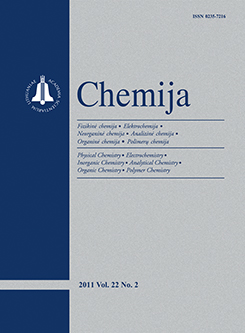Chemija / Chemistry
 ISSN 0235-7216 ISSN 2424-4538 (online) |
2011 m. Nr. 3 Essential oil constituents of Lavandula officinalis Chaix. from Northwest Iran
Lavandula officinalis Chaix. is a multidisciplinary medicinal and aromatic plant with special importance in pharmaceutical and fragrance industries as well as in herb garden design. The essential oil content in the inflorescences and leaves of lavender cultivated in Northwest Iran was found to be 6.25% and 0.64% based on dry weight, respectively. The oil was analysed by GC / MS. Thirty seven and thirty four components were identified, comprising 97.0% and 96.5% of inflorescence and leaf total oil, respectively. Oxygenated monoterpenes (86.4% versus 84.2%) were the predominant class of components in both organs studied. Linalool (33.7%), 1,8-cineole (17.1%), borneol (14.7%) and camphor (7.8%) were the highlighted constituents of inflorescence volatile oil. At the same time, 1,8-cineole (31.9%), borneol (24.0%) and camphor (16.1%) showed the greatest content in leaf essential oil. Cis- and trans-linalool oxide (3.5% and 3.3%) and terpinene-4-ol
(3.5%) were other components with notable amounts in the inflorescence oil. Meanwhile, cryptone (3.5%) was another appreciable compound in leaf essential oil. A comparative overview of the essential oil profile of Lavandula officinalis Chaix. plants from Northwest Iran revealed prominent quantitative and qualitative differences from previous reports from other parts of the world. In conclusion, the chemical and percentage composition of the analysed oils from Northwest Iran were characterized by the high content of linalool, 1,8-cineole and borneol, potentiating their use in related industries and lavender as an ornamental and aromatic herb. Keywords: Lavandula officinalis Chaix., GC / MS, inflorescences, leaves, linalool, 1,8-cineole, borneol |
Issues:
2017 - Vol.28 No. 1, No. 2, No. 3, No. 4 2016 - Vol.27 No. 1, No. 2, No. 3, No. 4 2015 - Vol.26 No. 1, No. 2, No. 3, No. 4 2014 - Vol.25 No. 1, No. 2, No. 3, No. 4 2013 - Vol.24 No. 1, No. 2, No. 3, No. 4 2012 - Vol.23 No. 1, No. 2, No. 3, No. 4 2011 - Vol.22 No. 1, No. 2, No. 3, No. 4 2010 - Vol.21 No. 1, No. 2-4 2009 - Vol.20 No. 1, No. 2, No. 3, No. 4 2008 - Vol.19 No. 1, No. 2, No. 3-4 2007 - Vol.18 No. 1, No. 2, No. 3, No. 4 2006 - Vol.17 No. 1, No. 2-3, No. 4 2005 - Vol.16 No. 1, No. 2, No. 3-4 2004 - Vol.15 No. 1, No. 2, No. 3, No. 4 2003 - Vol.14 No. 1, No. 2, No. 3, No. 4 2002 - Vol.13 No. 1, No. 2, No. 3, No. 4 2001 - Vol.12 No. 1, No. 2, No. 3, No. 4 |